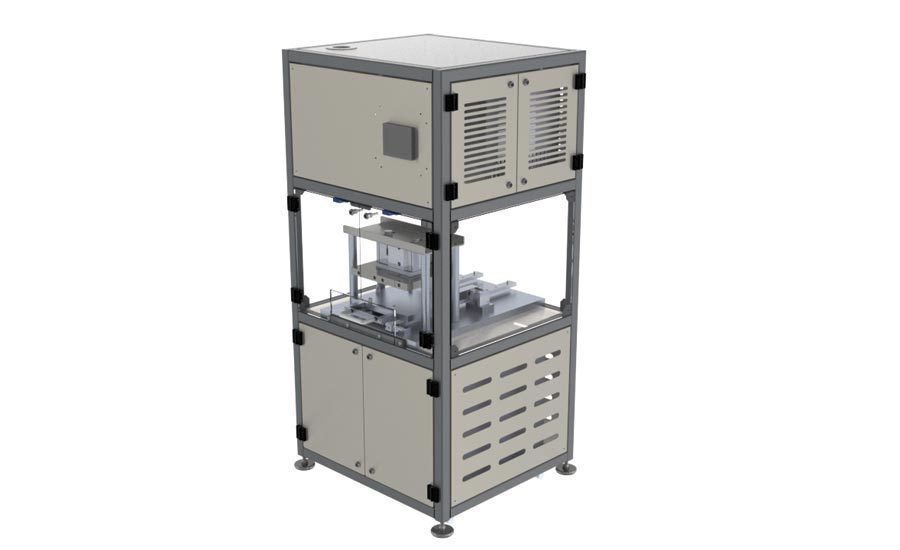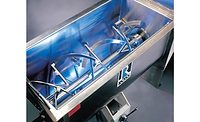CANNABIS PRODUCTS | JUNE 2020
Advancing cannabis edibles manufacturing through automation
Automating select aspects of cannabis-infused food and beverage production can bring strategic advantages.

courtesy of Erika Record Baking Equipment



Ever since California opened the door to legal sales of medical cannabis in 1996, cannabis-infused foods and beverages have been commercially available. Similar legislation progressively made its way across the U.S., providing relief for a wide range of conditions and ailments. Entrepreneurial businesses sprung up around legal cannabis to meet demand, and the nascent roots of a cottage industry began to grow.
But it wasn’t until 2014 when Colorado passed legislation permitting recreational cannabis use that this industry began to see exponential growth. More states followed suit, and in 2019, sales of legal cannabis in the U.S. reached $12.2 billion according to the 2020 update to “The State of Legal Cannabis Markets” report released in January 2020 from Arcview Market Research and BDSA.
For the latest insights on developing cannabis-infused food and beverages, visit cannabisproductsmagazine.com
But the best is yet to come. We are on the cusp of a new age of cannabis food and beverage product development. Passage of the 2018 Farm Bill nationally legalized non-psychoactive cannabidiol (CBD) derived from industrial hemp. And all eyes are now on FDA to provide guidance for use of CBD in foods and beverages. Once that final piece of the puzzle is securely in place, foods and beverages infused with CBD will become available to U.S. shoppers.
With this level of growth comes the need for more-sophisticated equipment, technology, and strategies to meet a far-greater demand for cannabis-infused foods and beverages. And incrementally adding automation to production processes is a great place to start.
Increasing Efficiency
There are multiple ways to measure efficiency gains when looking to automate your production, says Daniel DaRocha, president, Erika Record Baking Equipment, West Caldwell, NJ. “Of course, the first gain is always in being able to produce more product. With automation, you can extend your single product production runs, and minimize changeovers and downtime. In addition to longer runs, with increased automation there are gains of consistency, both in size and appearance.” He notes that automation also reduces the need for employees to handle the product.
Most of the work that Egan Food Technologies, Grand Rapids, MI, has done in the cannabis industry has been in chocolate molding and depositing, says Mike Sherd, managing partner. “We’ve helped some of the industry’s most well-known brands automate these steps in their processes in ways that allow them to scale when they’re ready for additional automation. By starting with just one step in the process—as opposed to an entire equipment line—most producers can manage automation with their existing staff.”
It’s also important for producers to have an end product that’s scalable, and to be open to slight process changes that will make automation possible, says Sherd. “For instance, the size of the product may need to be adjusted or the recipe tweaked when moving from a hand-forming process to automation. This also creates uniformity in the look of the final product, but more importantly, consistency for ingredients and dosages. For infused chocolate, there can be a lot of wasted and unaccounted for ingredients if your current process includes flooding a mold or filling every cavity by hand. A simple depositor can typically have a quick ROI for this reason alone.”
Automating the packaging process is another strategic area that can bring increased efficiency and quality. Nick Roelse, national sales and key accounts manager, Viking Masek, Oostburg, WI, notes that there are three critical keys to maximizing performance when it comes to automated cannabis packaging lines:
- Ensuring the multi-head scale is fed appropriately
- Weighing the product with speed and precision
- Accuracy and smooth transition into the finished package
These variables might sound simple, says Roelse, but can be difficult to achieve without proper expertise and experience. “Partnering with the right equipment manufacturer is a massive differentiator when it comes to successfully increasing production efficiency through automation.”
When making an investment in packaging automation, equipment lead times of weeks to months must be taken into consideration, says Roelse. “For this reason, it’s key to purchase based off both existing and future capacity demands. Typically, we tell customers to purchase for at least six to eight months of future capacity on top of current demands.”
Incremental Growth
Producers of cannabis-infused foods and beverages can strategically set up early stages of automation so that the equipment can grow with them as they add increased capacity and/or other product lines in the future. “This is all based on number of the employees and options available,” says DaRocha. “There are always basic ways that you can increase automation.” This might include purchasing larger mixers, larger ovens, and incorporating depositing/portioning machines.
“However, these decisions must be made inclusive of the larger picture,” says DaRocha. “For example, when you increase automation at the beginning of your production line—such as larger mixers—without addressing your downline equipment, you will create a bottleneck, or have product unnecessarily sitting and waiting. Likewise, if you increase automation further down line—larger ovens, cooling tunnels, dehydrators—but not in the beginning of the production line, you may not be utilizing your equipment to its fullest.”
This does not mean that a cannabis food and beverage producer should purchase a full line earlier than they need it, though, says DaRocha. “You should start by asking yourself if your company is maximizing efficiencies with their current employees and space. Could production flow be improved?”
In the early stages of establishing automation, cannabis-infused food and beverage manufacturers should seek out an equipment supplier who will be a partner through all stages of growth, says Sherd. “It’s very typical for customers who are currently hand-forming their products to start with a base depositor. When they’re ready for additional automation, they can look upstream and add a mixing tank or liquid doser to supply the depositor. Downstream, they could add mold shaking, product cooling, and/or automatic demolding over time. Because of our modular designs, Egan Food Technologies’ equipment is ideal for supporting our customers’ growth when they increase capacity in the future.”
When initially starting to work with a new or prospective customer, Egan Food Technologies will have the manufacturer typically send in sample products to evaluate, along with a video of their current production methods. “Sometimes we travel to the customer’s facility to see this process firsthand,” says Sherd.
“Back at our headquarters, we put their products through a series of tests to ensure it can be automated, and then we discuss which equipment might be the best solution for their product,” continues Sherd. “After the equipment is built, we’ll run factory acceptance tests in our shop. Customers can visit during that time to see their products running on the equipment, or we can provide video footage as an alternative to travel.” Egan Food Technologies also provides installation and training.
“Over time, we stay in contact with our customers to determine when they’re ready to add the next level of automation,” says Sherd. “It’s common to have a wish list of solutions from the very beginning, but to add those little by little so that customers can scale up automation at the right pace for their business.”
Overall Improvements
Automation creates significant improvements in product consistency and accuracy, says Sherd, which is directly linked to both quality and safety—especially in the cannabis industry. “Manufacturers can be more confident in the dosage of each product, and there are fewer overall touchpoints from humans. Oftentimes, products must be deposited at temperatures in excess of 200˚F, which creates burn risks when being done by hand. In that same scenario, a mold that’s being scraped by hand to remove excess product is going to have less uniformity than one being deposited according to specific measurements.”
Companies looking to add automated production solutions should also consider how the product may be handled, and how an existing recipe or production process may need to be adjusted to better accommodate the mechanization and automation of your production line, suggests DaRocha.
It’s always important to do your research prior to committing to an equipment purchase, says DaRocha. “This includes familiarizing yourself with local installation requirements and any potential production challenges during your transition to more-automated solutions.” Erika Record Baking Equipment offers hands-on and virtual demonstrations for customers, including availability of staff bakers to provide support, a comprehensive spare parts inventory, and delivering customer service both during and after the sales process.
“Our team includes experienced bakers who understand your unique production needs,” says DaRocha. “We are able to have an honest conversation about a company’s current production and projected growth.”
Removing the potential for human error from the packaging process poses benefits, says Roelse. “It’s extremely consistent and repeatable, which increases product quality and safety. With automated packaging machines handling the process, the product can be handled in a way that’s specific to its needs, which ensures the best product quality.” Safety risks and hazards are also significantly reduced, both for the worker and the consumer. “This is especially important during a public health crisis, when minimal human involvement is both desired by consumers and a reality, with workers being in short supply.”
Viking Masek provides a certified technician that travels to a customer’s facility to help install, commission, and train employees on the new machine, says Roelse. “After the technician goes home, we continue to provide full-service support the customer with a dedicated team consisting of mechanical and electrical experts who are available around the clock to make sure our customers are maximizing machine performance and uptime.”
Cannabis food and beverage companies are often made up of great teams with visions for exceptional products, says Sherd. “They know marketing, sales, and business operations, and have a great understanding of the industry, but they don’t always see themselves as having the technical know-how for automation. Because of this, we see some manufacturers leaning into co-packing instead of investing in their own equipment. But with the right equipment partner in place, producers can confidently transition to automation, and it’s only going to help their business in the long run.”
Looking for a reprint of this article?
From high-res PDFs to custom plaques, order your copy today!









